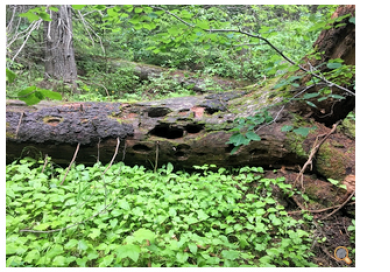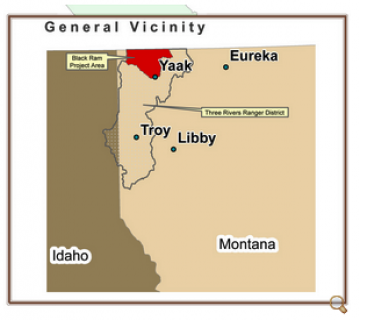Ancient Forests, Climate Refugia, and Northern Rockies' Critical Habitat for the Yaak Valley's 25 Grizzlies Threatened by United States Forest Services' Black Ram Proposal to cut 60 MILLION board feet with NO Environmental Impact Statement!
To ALL Forest Protectors,
Critical Habitat in the Northern Rockies IS in danger!
Apologies for the late request on this most important action. IEN received a request to put this out to our family of supporters late today, August 7th. Therefore, this is a compilation of information that you can use for your comments - we can't stress the importance of acting on this request enough - please help!
What's at Stake:
A pristine healthy rain forest ecosystem is at stake with this Black Ram Project. It will surely destroy precious biodiversity, sacred trees and our forest relatives by the millions!
Public comments and/or statements demanding an EIS as a minimum are Due by 8/8. This is a 3-5 minutes to read and it should only take 5-10 minutes for you to respond.
Send comments to: [email protected] with a copy to: [email protected] [email protected], [email protected], [email protected], [email protected], and www.tester.senate.gov/contact
Please share this newsletter (Link below in footer) to all who might feel strongly about protecting this rain forest from destruction. You can also share with your social media network with links provided in the header and footer of this message.
Word is that few people/organizations are actively working to oppose this. Another in a long line of actions by the forest industry and the USFS hiding what's planned because they know, if we know, we can't stand by and watch this happen. AND since we were notified, even this late, we're blasting out this appeal for support.
Our sincere appreciation for taking action with us,
BJ McManama
Save Our Roots Campaign Organizer
[email protected]
LEARN MORE and Information you need for your comments:
 In addition to being the stronghold of the last 25 grizzlies in the Yaak Valley, the northwest corner of Montana holds one of the great stalwarts for any successful plan for the western United States to successfully weather the rising tide of global warming. In addition to being the stronghold of the last 25 grizzlies in the Yaak Valley, the northwest corner of Montana holds one of the great stalwarts for any successful plan for the western United States to successfully weather the rising tide of global warming.
The Yaak Valley, at the southernmost tip of the Purcell Mountains—Canada’s largest mountain range—is uniquely positioned between the maritime systems of the Pacific Northwest, which are governed by rot, and the dryer weather pattern of the northern Rockies, governed as they are by fire.
The Yaak is both the lowest elevation in Montana as well as the northernmost, and the wettest—an inland rain forest.
For these reasons and more, the Yaak is uniquely positioned to serve as Montana’s and the West’s climate refuge. We are already seeing signs of new species immigrating as ecotypes elsewhere fragment and wither.
It’s a grand biological experiment already in process, and with the Yaak consisting of 97% public land (U.S. Forest Service--USFS), it offers Montana’s best hope at retaining some semblance of ecological integrity and relative stability amidst the violent disturbance occurring elsewhere. Such an important bioregion and climate refuge can serve as an invaluable stronghold of natural diversity that will function and help to repopulate/regenerate other areas of the Rockies once we moderate or reverse global warming, many years from now.
The Yaak is home to an amazing community of threatened, endangered and sensitive species, including rare forest types.
 The Yaak was once comprised of as much as fifty percent old growth—particularly old larch, a tree well-suited to the coming fire-scape of the West. The Yaak is Montana’s only inland rain forest, and its northern tier, according to Canadian forester and ecologist Dr. Herb Hammond, contains a singular band of forests in which no fire scars can be found, dating back at least a thousand years—unprecedented biological rarity that appears to be due in part to a perched water table. Numerous fens, marshes, springs and creeks lace this high elevation headwaters forest. The Yaak was once comprised of as much as fifty percent old growth—particularly old larch, a tree well-suited to the coming fire-scape of the West. The Yaak is Montana’s only inland rain forest, and its northern tier, according to Canadian forester and ecologist Dr. Herb Hammond, contains a singular band of forests in which no fire scars can be found, dating back at least a thousand years—unprecedented biological rarity that appears to be due in part to a perched water table. Numerous fens, marshes, springs and creeks lace this high elevation headwaters forest.
Most disturbingly, the USFS is using the language of global warming to justify this regeneration harvest prescription for the vast majority of proposed treatments in the area, with 36 proposed units exceeding the USFS’ own forest plan maximum of 40 acres. The USFS claims these prescriptions—which will remove between 800-100% of the canopy of these ancient forests will make them more “resilient” and “resistant.” Included in these regeneration harvest prescriptions is Unit 72, the scientific rarity of a thus-far fireproof alpine forest with a perched water table, which appears to never have burned.
With the U.S. Forest Service proposing “regeneration harvests” this will result in whatever spindly few trees are eft will die or blow over within a season—of over 2600 acres in the epic Black Ram proposed timber project on the international border, which would take roughly 60 MILLION board feet out of this northern tier of Montana. Many of the openings—hundreds of acres in size--would take place atop the source of the Yaak River, where it first comes into the United States from Canada—headwaters for wildlife and the drinking water for communities.
This is an important ACTION NEEDED BY YOU NOW!!! Send a message to the Department of Agriculture and U.S. Forest Service about the need to be mindful of the benefits of passive firefighting measures, and the need to PROTECT and maintain systems in the public portfolio that sequester carbon.
These are OUR PUBLIC LANDS:
Demand an EIS to address the environmental consequences of such severe logging in high elevation wet forests, along with so many other issues.
Send comments to: [email protected] with a copy to: [email protected] [email protected], [email protected], [email protected], [email protected], and www.tester.senate.gov/contact
Additional information to help you compose your comments and emails:
This ancient sub-boreal band of never-burned forest in the upper Yaak Valley, with its elevated water table, that could be converted into a biological desert of sun-blasted arid-dead-bleak landscape if the Black Ram project proceeds as planned.
You can help protect the last 25 Yaak grizzlies and defend the great carbon-absorbing and moisture-preserving lungs of the northern Rockies’ inland rainforest, the Yaak, with a letter protesting the Kootenai National Forests’ epic clear cuts and other damaging activities to public land and water in the Black Ram project prior to August 8th 2019.
More that can be included in your comments, beyond Yaak grizzlies, water, carbon sequestering and fire suppression:
- The project would place regeneration harvests on top of the controversial high-volume through-hiker Pacific Northwest Trail (PNT), which already disrupts vital core grizzly habitat in this region, and directs hikers to travel on paved logging roads during the haul of 60 MMBF. The Black Ram project would also build unauthorized spur trails to the PNT.
- The project is far too large, and requires Environmental Impact Statement. The current “analysis” is shoddily written, vague, ineffective, contradictory.
- The project disrupts grizzly core habitat;
- Fails to address public’s and stakeholders’ need for wildness in the project area
- builds ill-advised trails, and roads in old growth;
- fails to analyze fires and new road construction;
- fails to address cumulative effects;
- fails to protect wildland-urban interface;
- fails to address wildlife connectivity and corridors;
- A project area this large requires a landscape level planning;
- The project’s proposed treatments, in conjunction with non-analyzed cumulative effects of Spread-Thin cuts, new roads, Davis Fire, Davis “fire break,” prescribed burns, and proposed large openings, would be devastating to headwaters of Yaak River.
All of the above information to include a beautiful video, where to send your comments and emails can be found at Save the Yellowstone Grizzly at: https://savetheyellowstonegrizzly.org/yaak-valley-black-ram-project
|